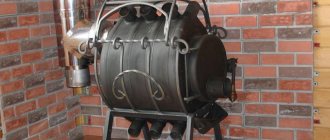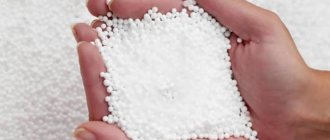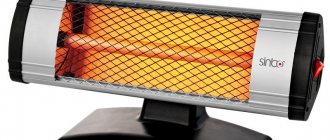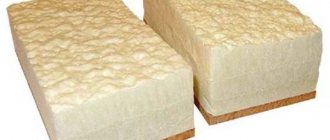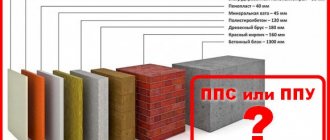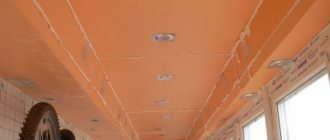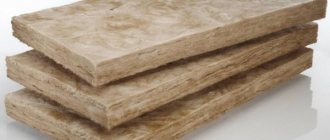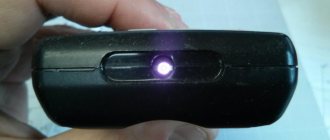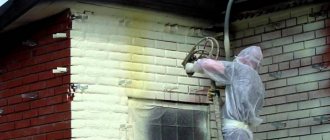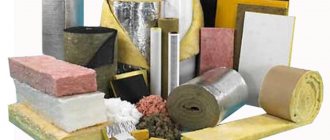Spraying polyisocyanurate foam
Polyisocyanurate foam or PIR is a modern polymer thermal insulation material reminiscent of polyurethane foam in its properties.
Foamed polyisocyanurate is obtained in a similar way as a result of the reaction of two components. The main advantage of polyisocyanurate foam is that it is practically non-flammable. Polyisocyanurate foam has a flammability class of G2, confirmed by fire certificates.
Groups of polyisocyanurate foam belonging to the fire safety certification system.
- Flammability group G2 according to GOST 30244-94 (moderately flammable according to SNIP 21-01-97)
- Flammability group – B2 according to GOST 30402-96 (moderately flammable according to SNIP 21-01-97)
- Group for smoke-forming ability – D2 according to GOST 12.1.044-89 (with moderate smoke-forming ability according to SNIP 21-01-97)
In other words, polyisocyanurate foam does not support combustion and goes out on its own in the absence of a fire source.
PIR has a fairly low thermal conductivity coefficient of 0.023. With such indicators, it is second only to polyurethane foam.
Polyisocyanurate foam can be obtained either by spraying or by pouring.
Spraying is quite convenient for thermal insulation of complex geometric structures. Application of polyisocyanurate foam allows you to obtain seamless thermal insulation with the absence of cold bridges. Polyisocyanurate foam can be sprayed in several layers to achieve the required thermal insulation thickness.
Polyisocyanurate foam has certificates of compliance with sanitary and epidemiological standards, which confirms its safety for both humans and the environment.
The recommended temperature regime for spraying polyisocyanurate foam is from +10 to +30 degrees Celsius. In this case, there will be a minimum consumption of raw materials and maximum foaming of the components.
Polyisocyanurate foam is sprayed onto a dry and grease-free surface. Otherwise, expect the sprayed layer to peel off from the surface. Spraying is recommended to be carried out in several layers of 5 - 15 mm each, gradually reaching the required thickness. This fact is due to the fact that when sprayed in layers, a membrane film will be formed between them, which provides additional hydro and heat protection. In addition, in this way it is easier to achieve insulation with the same thickness over the entire area, eliminating waste of raw materials.
Despite the fact that the material is safe, when performing work on spraying polyisocyanurate foam, the operator must wear special clothing. This is due to the fact that spraying polyisocyanurate foam is associated with the formation of a fine suspension of foaming PIR components. This suspension should not get into the eyes, respiratory tract or exposed skin. Usually, for this purpose, the foamer works in a gas mask, gloves and protective overalls.
Our company manufactures equipment for spraying polyisocyanurate foam. The range of equipment can be found in the spraying equipment section.
We also supply isocyanurate components for spraying and pouring.
tel. email
Is a polyurethane foam insulation layer harmful for residential premises?
This question concerns the vast majority of amateur builders, since very often special additives are a production secret, and it is not possible to find out how harmful polyurethane foam is. Any mixture produced undergoes the most stringent tests to confirm its non-toxicity under different operating conditions. So the actual harm to polyurethane foam is zero if you use a mixture from a trusted manufacturer that has all the necessary quality and safety certificates.
Installation
Which pillow is better, bamboo or eucalyptus
? PIR insulation is produced in the form of ready-made panels coated with kraft paper, foil or as part of sandwich panels. Each option has its own area of application and methods of insulation. In addition to design differences, there are ready-made solutions for insulating separate walls, ceilings and roofs.
Sandwich panels
This is a ready-made wall structural material for creating insulated one-story buildings or for forming the walls of frame houses with more floors.
The panels are joined together with a locking connection. The joints are additionally blown with foam or glued with a special polyurethane construction adhesive. It is possible to connect panels using such structural elements as a frame made of a profiled pipe or angle. The panels are fastened with bolted connections to wide sheet steel backings with a thickness of at least 3 mm to ensure rigidity and not damage the insulation layer.
Wall panels
The standard size of a PIR insulation wall panel is 600x1200 mm, the thickness is selected depending on the required insulation.
The sheets are laid end-to-end, using a quarter or a lock. Lathing is not required; the material is attached to the insulated base with special plastic dowels with a wide head, as is the case with EPS.
Additionally, sheets lined with kraft paper can be glued to the base using any tile or polymer adhesive.
For roofing
In fact, this is a type of sandwich panel, however, the panel is often protected with a steel sheet only on the upper side, where the usual waves are additionally formed at the joints to ensure the tightness of the roof.
The bottom side of the slabs is covered with kraft paper or foil. The installation process is similar to laying profiled sheets along the rafters. A flat roof surface with the required slope is formed.
Insulation for floors
In fact, a direct analogue of wall material, however, slabs are used more often in square or rectangular shapes with a lock on all four sides. No additional fastening is required.
A mandatory damping tape is laid around the perimeter of the insulated floor, and then the entire area is laid with slabs. On an insulated floor, you can form a dry or wet screed, a heated floor system, etc.
https://youtube.com/watch?v=YlhSDF5Fr5k%3F
Pros and cons of polyurethane mattresses
The advantages of polyurethane mattresses are obvious:
- The optimal combination of quality and price.
- Has orthopedic properties.
- Hygienic (does not rot, is indifferent to pests).
- Do not cause allergic reactions.
- Completely safe filler.
- Long-term operation and preservation of quality.
- Easy to care for and clean (not afraid of water).
While sleeping on a polyurethane mattress, the filler seems to adapt to the contours of the person’s body, supporting it and relaxing the muscles. Despite this, the mattress is quite elastic; it properly supports the spine, improves blood circulation, thereby eliminating congestion in the body. Polyurethane mattresses are recommended for overweight people, bedridden patients during postoperative periods, or during periods of illness, as they prevent the occurrence of bedsores.
Undoubtedly, it is pleasant that a polyurethane mattress will not stick together, deform or wrinkle. If there is a need for transportation, it can be easily rolled up and transported to the desired location, after which it will again take its original shape.
With such significant advantages, polyurethane mattresses also have disadvantages. Namely:
- Quickly absorbs liquid, even evaporation.
- Cheap polyurethane mattresses quickly wear out and become deformed.
- Requires careful care (ventilation, cleaning).
- Relatively short service life of up to 10 years.
After its service life (more than 10 years), polyurethane gradually deteriorates, it becomes deformed, and this immediately affects its orthopedic properties, comfort of sleep and rest. The disadvantages of polyurethane mattresses are insignificant and they are fully compensated by its advantages, but whether to buy it or not, everyone must make their own choice.
Related Posts
- Steel x12MF for knives: characteristics, pros and cons
- Eucalyptus blanket: pros and cons of choice
- Steel 110x18 for knives: pros, cons and features
- Pros and cons of vacuum packaging
- Satellite TV: advantages and disadvantages
- Hoverboard: pros, cons and what you need to know
- Electric stove: advantages and disadvantages
- Solid fuel boilers - pros and cons of choice
How to make a foam mattress with your own hands
Experts recommend using exclusively orthopedic mattresses in everyday life; in addition to comfortable rest, it also prevents diseases of the musculoskeletal system. Unfortunately, the price of factory-made mattresses is quite high and not everyone can afford it. Meanwhile, making a foam mattress with your own hands is not such a difficult task.
The structure of a factory orthopedic mattress
When sewing a mattress, you can go in two ways:
- simplify the task as much as possible and use a thick layer of highly elastic material as a filler. After cutting, all that remains is to process the edges of the material, cover it with fabric and place it in a case. A 10 cm foam mattress created in this way will be quite convenient and comfortable;
- You can complicate the task and try to combine a layer of foam rubber and a spring base in the mattress. In this case, the output will be an analogue of factory-made orthopedic mattresses.
One of the best options is a spring base with independent springs. In this case, a person is guaranteed to be able to take a comfortable position. In the proposed design, the spring base will be placed in a box glued together from pieces of foam rubber. For the side edges, you can use foam rubber with a thickness of about 30 mm, but for the top and bottom parts - at least 50 mm. You will also need felt, fabric for covering the mattress and sewing a cover, and braid.
Main part of the mattress
The base of the mattress is a structure consisting of two layers of foam rubber, two layers of felt and a spring base located between them. After cutting the foam rubber and felt, a layer of foam rubber is first laid on any horizontal surface, then there is felt, a spring base, again a layer of felt, and this “pie” is covered with a layer of foam rubber. Felt is used here to prevent springs under load from damaging the surface of the polyurethane.
The structure of the future mattress
The free space on the sides should be covered with inserts made of the same polyurethane, and the result should be a closed box. It is better to use special glue to glue the elements of the box. You can get by with regular PVA or liquid nails, but, firstly, the drying time of the adhesive layer will increase, and secondly, a hard crust will form at the gluing site, which will simply crack when deformed.
Glued mattress base
There is no need to additionally fix the felt and spring base. They will not move during use.
For additional strength, when gluing, you can place a wide board on the foam rubber and place a load on it.
Instructions for sewing a cover
For the cover you will need batting and fabric; when cutting, you just need to take into account the dimensions of the foam “box”. And, of course, leave a reserve for finishing the edges.
In the first stage, the batting is sewn to the fabric. On a flat surface, the batting and fabric are aligned with each other and hand stitched along the long side of the rectangle several times. After this, you can proceed to processing the edges.
First, the excess batting that protrudes beyond the fabric is cut off, after which the part of the future cover is stitched around the perimeter with an overcast stitch. After this, you can sew the narrow parts of the cover into one whole.
Large pieces should be sewn on using decorative tape to hide the seam. First, the braid is sewn along the perimeter of the large part, then the edge of the narrow part is applied to the same braid, the braid is folded and stitched. Using the same principle, a zipper is also sewn on so that the mattress can be taken out when washing the cover.
Ready mattress
How harmful is polyurethane foam to human health?
Choosing an orthopedic pillow for sleeping
One of the materials widely used in the construction field is polyurethane foam.
Among the main areas of its application are:
- insulation of refrigeration chambers;
- insulation of residential premises;
- thermal insulation of commercial buildings;
- thermal insulation of pipelines.
Receiving material
It is obtained from components in a liquid state; their dosage and mixing are not particularly difficult. Based on this, the material is produced at industrial enterprises, also at the place of its use.
The foaming and curing process occurs instantly: within a few minutes, the product is ready for use.
Using polyurethane foam indoors: how justified is it?
Due to its popularity, polyurethane foam and everything connected with it are overgrown with speculation and legends. First of all, they are associated with the harmfulness of polyurethane foam to the health of citizens.
Disadvantages of polyurethane foam affecting human health
- It is believed that the material is not suitable for residential premises due to its flammability. During a fire, it can release toxic gases that are harmful to health.
- Under the influence of ultraviolet rays, insulation decomposes into monomeric products, which will negatively affect the health of the person living in the house.
- The material is not sufficiently resistant to moisture, which causes the release of harmful vapors from the material. Regular poisoning with these vapors leads to pathologies in the human body. In particular, this is related to the functioning of the immune and cardiovascular systems.
The unique thermal conductivity of polyurethane foam: how true is it?
Lack of truthfulness in the description and properties of a product can lead buyers into a depressed state, which can also negatively affect people’s health.
Are there new insulation developments that cannot harm people?
Currently, manufacturers claim that the use of the material excludes the inclusion of various ether fractions in its composition.
In particular, the new modern material, which is distinguished by its quality and environmental safety, does not contain:
- asbestos;
- freon;
- highly volatile ether fractions;
- formaldehyde.
Copying without the written consent of the copyright holder is punishable by law.
Is foam rubber harmful?
Since then, the name has been assigned to it and is still practiced, since it is quite difficult to call it polyurethane foam in everyday life.
Today, when our fellow citizens are finally concerned about the harmfulness of household items, it’s time to write about the properties of this elastic material.
According to its properties, the material is an elastic, soft foam made from polyurethane. The hollow cells contain air, which explains its very low weight.
The scope of its application is quite wide, but the main areas remain heat and sound insulation, giving softness and elasticity to most household items, for example, upholstered furniture.
In the process of making foam rubber, a large number of foam stabilizers, isocyanates, polyol, and catalysts are used. It is now generally accepted that these components can evaporate and cause significant harm to the health of those who come into contact with them. This fact has not yet been confirmed, and the manufacturers themselves insist that all these components are in a bound state, so they simply cannot be released. If they are released, then under the influence of moisture in the air, they almost immediately decompose into harmless substances.
True, in some cases, polyurethane foam can be harmful to human health, since when burned this substance emits highly toxic gases, so the material should not be allowed to ignite.
Manufacturers add thermosetting substances to the composition of foam rubber to withstand high temperatures, but have not yet completely gotten rid of the flammability of polyurethane foam.
We cannot ignore the fact that the service life of foam rubber does not exceed ten years. Subsequently, the chemical substances contained in its composition begin to be actively released during the decomposition of complex compounds
These substances have pronounced carcinogenic properties, so storing polyurethane foam for more than ten years is not recommended.
Production of polyurethane foam and flammability of elastic polyurethane foam for furniture and mattresses
Two-component polyurethane
The production of polyurethane foam in the sector of production of elastic polyurethane foams is associated with their use in the production of upholstered furniture, mattresses, office chairs and armchairs, in the automotive and textile industries. The production of polyurethane foam uses technologies for the production of elastic polyurethane foams in the form of blocks or molded polyurethane foams. High quality elastic block polyurethane foam is usually produced in a continuous manner using a conveyor and modern equipment. In case of low requirements for the quality of the material, elastic block polyurethane foam is obtained by periodically pouring the foaming composition into a box. Modern box installations have vacuum chambers, which makes it possible to produce elastic polyurethane foam of low apparent density up to 20 kg/m3 without the use of methylene chloride, as well as elastic polyurethane foam of standard and lower than standard rigidity.
The production of polyurethane foam for furniture use is associated with the unique useful physical and mechanical properties of elastic polyurethane foams, including low apparent density, elasticity, virtual absence of odor, and the ability to quickly restore size and shape after deformation. That is why the production of polyurethane foam is used in the manufacture of upholstered furniture and mattresses. Elastic polyurethane foam for furniture is obtained by reacting a polyol with a diisocyanate in the presence of foaming agents, catalysts, surfactants, antioxidants, dyes, and fire retardants. The fire safety of elastic polyurethane foam is one of the most important characteristics of these materials, since it largely determines the safety of upholstered furniture and mattresses.
PUF ignites when exposed to a sufficiently powerful heat source, and the combustion characteristics of elastic PUF include such indicators as ease of ignition, smoldering ability, flame spread rate, heat release rate, smoke formation, and toxicity of combustion products. The fire safety of elastic polyurethane foam can be improved by changing the composition of the polymer matrix and adding fire retardants to the formulation. The production of polyurethane foam and the use of elastic polyurethane foam in combination with various furniture upholstery fabrics can significantly affect the flammability of the final product.
Cigarettes, dry alcohol tablets, newspapers, and gas burners are often used as ignition sources for testing the fire hazard of products with PU foam filler. Such tests show the dependence of the flammability of upholstered furniture on the type of shell used, the configuration of the final product, the formulation of elastic polyurethane foam, and the combustion source. To predict the behavior of a complex product in a specific fire situation, one does not limit oneself to the results of laboratory flammability experiments, but conducts appropriate large-scale flammability tests of finished products.
The best springless natural fillers
Any filler that is used in the production of upholstered furniture or mattresses has its own properties.
Natural latex. It is made from the sap of the rubber tree using individual technology. It is foamed, resulting in the formation of cells, so it “breathes”. Excellent heat and moisture conductivity, solid material, very high quality. Shelf life is approximately 10 years. Instantly returns to its original shape after heavy loads. There is only one drawback - the very high price.
Latex mattress - high quality, comfortable and safe
Horsehair. Excellent filler. The horse's mane is treated with latex. This is done to ensure that the material is elastic and long-lasting, moisture-resistant, and breathable. High quality filler, but expensive. Not suitable for people prone to allergies.
Horsehair for the production of upholstered furniture and mattresses
Coconut coir. Fibers are produced from the coconut intercarp; just like horsehair, they are treated with latex to make them elastic and strong. In addition, they also have antibacterial properties, are hypoallergenic, environmentally friendly, do not rot, and are breathable. Furniture with such filling is perfect even for small children.
Coconut filling for children's mattress
Sea grass. The most environmentally friendly filler. During manufacturing, the raw material is combined with jute. The furniture has sufficient rigidity, which is beneficial for the back and maintaining the health of the spine. In addition, this filler strengthens the immune system and normalizes sleep, as it contains iodine and various minerals.
Useful and healing filler for upholstered furniture - sea grass
Bamboo fiber. Produced from young bamboo shoots. The material is able to absorb water vapor, allow air to pass through, and has anti-allergic and antibacterial properties. It is not subject to rotting and does not deform for a long time.
Bamboo fiber is ideal for mattress covers, blankets and pillows
Camel's wool. Excellent breathable material, can absorb static electricity. Not suitable for people prone to allergies.
Camel wool is an excellent warm filling material for blankets, pillows, blankets, mattress covers and winter mattress options.
Felt. Made from sheep's wool. Has good thermal conductivity. One of the disadvantages is that it can accumulate moisture, which can cause mold to appear.
Natural felt for furniture and other industries
Is phenol a big threat?
Phenol is considered a toxic substance because it emits toxic fumes, and this process can continue for years without reducing or losing toxicity. This chemical element can cause disruption of the most important systems of the human body: respiratory, nervous, cardiovascular. The consequence may be headaches, loss of consciousness, and impaired coordination of movements. Kidney and liver function may also be affected. Constant contact with phenol and its vapors can cause the appearance of such serious diseases as asthma, infectious pulmonary pathologies, and allergies.
According to scientists involved in research in this area, the use of polyurethane foam for the manufacture of children's furniture, mattresses, and toys is unjustified. Polyurethane foam may well be replaced with safer materials. If parents are concerned about the health of their children, they need to be very careful when choosing toys and mattresses for them, in which polyurethane foam can be used as a filler. The majority of civilized countries have banned the use of phenol for the manufacture of everyday goods.
Video: Mattresses made of polyurethane foam, foam mattresses, types of polyurethane foam
Polyurethane foam is most often positioned as a “green” building material due to its energy-saving properties. It insulates better than fiberglass or cellulose, as well as many other materials. However, when assessing environmental friendliness, it is important to consider whether polyurethane foam in liquid or solid form is harmful to health. When considering materials such as polyurethane foam, health harm is assessed by analyzing the side effects that can be caused by the chemicals in its composition. When dried, a correctly applied layer of polyurethane foam does not emit any substances into the atmosphere; harmful fumes are possible only with unprofessional handling. Let's look at the worst case.
CLAIM
1. A method for producing rigid polyisocyanurate foam, comprising reacting, at an isocyanate index of about 175 to about 400, the polyisocyanate with at least one natural oil polyol containing at least about 35 wt.%, based on the weight of the natural oil polyol, having a hydroxyl number of about 175 to about 375 and hydroxyl functionality from about 2.0 to about 2.8; in the presence of a foaming agent; and optionally in the presence of one or more surfactants, flame retardants, pigments, catalysts and fillers, wherein the resulting foam has a renewable bio-based material content of at least 8% by weight.
2. The method according to claim 1, in which the polyisocyanate is selected from the group consisting of m-phenylene diisocyanate, p-phenylene diisocyanate, 2,4-toluene diisocyanate, 2,6-toluene diisocyanate, 1,6-hexamethylene diisocyanate, 1,4-hexamethylene diisocyanate, 1, 3-cyclohexane diisocyanate, 1,4-cyclohexane diisocyanate, hexahydrotoluene diisocyanate and their isomers, isophorone diisocyanate, dicyclohexylmethane diisocyanates, 1,5-naphthylene diisocyanate, 4,4′-diphenylmethane diisocyanate, 2,4′-diphenylmethane diisocyanate, 4,4′-biphene ylene diisocyanate, 3.3′ -dimethoxy-4,4′-biphenylene diisocyanate, 3,3′-dimethyldiphenylpropane-4,4′-diisocyanate, 2,4,6-toluene triisocyanate, 4,4′-dimethyldiphenylmethane-2,2′,5,5′-tetraisocyanate and polymeric diphenylmethane diisocyanate (PDIC).
3. The method according to claim 1, wherein the polyisocyanate is a polymeric diphenylmethane diisocyanate (PDIC).
4. The method of claim 1, wherein the at least one natural oil polyol is present in an amount of at least about 40 weight percent, based on the weight of the natural oil polyol.
5. The method of claim 1, wherein the at least one natural oil polyol is present in an amount of at least about 45 weight percent, based on the weight of the natural oil polyol.
6. The method of claim 1, wherein the at least one natural oil polyol has a viscosity at 25°C of less than about 2000 cP.
7. The method of claim 1, wherein the at least one natural oil polyol has a viscosity at 25°C of less than about 1000 cP.
8. The method of claim 1, wherein the at least one natural oil polyol has a viscosity at 25°C of less than about 500 cP.
9. The method of claim 1, wherein the at least one natural oil polyol has a viscosity at 25°C of less than about 200 cP.
10. The method of claim 1, wherein the at least one natural oil polyol has a hydroxyl number of about 200 to about 350 and a functionality of about 2.0 to about 2.5.
11. The method of claim 1, wherein the natural oil is selected from the group consisting of canola oil, castor oil, coconut oil, corn oil, cottonseed oil, jatropha oil, flaxseed oil, olive oil, palm oil, palm kernel oil, peanut oil , poppy oil, soybean oil, sunflower oil, tall oil, tung oil, tallow and mixtures thereof.
12. The method according to claim 1, wherein the blowing agent is selected from the group consisting of cyclopentane, n-pentane and isopentane and mixtures thereof.
13. The method of claim 1, wherein the isocyanate index is from about 250 to about 350.
14. The method of claim 1, wherein the isocyanate index is from about 270 to about 310.
Component composition of polyurethane foam
The main components included in polyurethane foam and necessary for the formation and attachment of polymer chains are polyol (component A) and polyisocyanate (component B). Sometimes domestic manufacturers can add another component to the polyol - a catalyst. The main components of polyurethane foam have a specific odor and are a liquid of a fairly thick consistency with shades from light yellow to dark brown.
During long-term storage, the polyol tends to exfoliate, so it is recommended to mix it before use. Polyisocyanate interacts with water - upon contact, crystallization begins. During long-term storage in the open air, a film forms on the surface of the material. According to its component composition, polyurethane foam can be of two types - for spraying and for pouring.
Polyurethane foam and harm to health: how to avoid negative consequences?
There are three main mistakes made when working with PPU:
- Failure to comply with operating requirements
- Ignoring protective equipment in direct contact with liquid foam mixtures
- Using low-quality sprayers
To minimize the inhalation of spray fumes or their deposition on internal surfaces, it is recommended to ensure good ventilation of the treated area.
Our article about polyurethane foam spraying technology will help you avoid the first two mistakes. Regarding the sprayer, it is preferable to use high-pressure apparatuses, which ensure uniform mixing of both phases of the mixture with 100% completion of the chemical reaction, due to which the question of whether the components of polyurethane foam are harmful disappears. In addition, this spraying ensures guaranteed quality of the coating.
Polyurethane foam (PPU) has universal properties. It is used almost everywhere. It is widely used as a thermal insulation material for external and internal insulation of polyurethane foam walls, floors, ceilings, roofs, as well as for proper insulation of a house with polyurethane foam in general.
People often ask questions about its safety. There is an opinion that polyurethane is harmful to health. But manufacturers claim the opposite, talking about its safety and environmental friendliness.
Of course, we cannot ignore this issue. It’s worth looking into everything and finding out the real truth about this widespread material.
Scope of application of polyurethane foam
This modern building polymer has found wide application in various areas of human activity. Its widest area of application is in construction: thermal insulation, acoustic and waterproofing of civil and industrial facilities for any purpose (residential, country houses, workshops, warehouses, hangars, etc.). Due to low thermal conductivity, polyurethane foam is used to insulate not only roofs, but also walls, both inside and outside buildings. Sandwich panels made of polyurethane foam are indispensable in the construction of prefabricated construction projects.
Polyurethane foam with a density of 30-86 kg/m³ (rigid polyurethane foam) is used as a noise and heat insulation material. Material with a density of 70 kg/m³ has a dense structure, does not allow water to pass through and is successfully used for waterproofing work.
In the production of refrigeration equipment, polyurethane foam is used as a cold insulator. The shoe industry uses the material to make various shoe elements and instep supports.
However, there are areas where the benefits of using a material such as polyurethane foam are very questionable. Lining material and fillings for upholstered furniture, mattresses, pillows, etc. can be harmful to health. (polyurethane foam with a density of 5-40 g/m³ - soft foam blocks). Although PU foam manufacturers claim that the material is environmentally and biologically neutral, its use as a filler for children's toys can also make parents think about the health of their children.
Properties of polyurethane foam
Polyurethane foam produced by domestic and foreign manufacturers has a number of both positive and negative characteristics.
The low thermal conductivity of the material (0.019 - 0.03 W/m), almost complete vapor tightness, and water resistance make polyurethane foam an excellent heat and water insulator. The same can be said about sound insulation. The high adhesion coefficient makes it possible to apply polyurethane foam to almost any surface.
However, polyurethane foam is not characterized only by its positive qualities. Harm to human health can be caused during the burning of polyurethane foam (in the presence of a direct source of fire, the material burns). In addition, polyurethane foam releases toxic substances into the atmosphere - formaldehyde. Polyurethane foam, the components of which interact with air and water, is not resistant to sunlight. Over time it darkens and falls off.
Sleeping in the arms of PPU
We will talk about such bedding items as polyurethane foam mattresses. Harm, quite serious, can be caused by inhaling fumes of complex volatile chemical compounds (about 30 types), the most dangerous of which are phenol and 2-ethylhexanoic acid. Moreover, new mattresses filled with polyurethane foam emit 5-6 times more hazardous substances into the atmosphere than old ones. The concentration of vapors of these substances is comparable to emissions from a new laminate flooring.
Assurances about the safety of mattresses filled with polyurethane foam are questionable for the simple reason that at the stage of their manufacture resins, catalysts, solvents, and active chemical components (phenol!) are used.
What is there in PPU that you should be afraid of?
If you look at the chemical composition of polyurethane foam, then at first glance, the mixture is indeed simply terrifying. Here's a look at what's involved in the process of making this foam, which resembles foam rubber:
- Arsenic
- Phosphorus
- Tin
- Tertiary amine
- Toluene
- Phenol
- Double isocyanite
- High molecular weight alcohol
- Silicone surfactant
- Chemical dyes
But... Just for fun, find the composition of regular baker's yeast on the Internet. The composition there will be no less interesting! And in general, if you take any non-natural substance apart, the list of chemicals will be frightening.
But in fact, when polyurethane foam has reacted and hardened, it does not release into the atmosphere any of the terrible toxins that advocates of environmentally friendly things attribute to it.
Polyurethane can release poison, in the literal sense of the word, in one case: combustion and heating above 200 degrees. But is it possible for the temperature in the apartment to rise like that? Or did you yourself, in a dream, take it and get hot?
It’s not advisable to iron it, yes. However, this applies to almost everything. You cannot heat laminate, plastic, plastic, lenoleum, suspended ceilings... No matter which way you look, there is harm everywhere.
Regular glass contains lead. The dishes, no matter how you start to disassemble them into molecules, also release the most terrible substances into the food, which are not comparable to life at all. So, do you eat from clay bowls now? So there, if you look closely, you can detect a large dose of radiation. In asphalt too, in concrete too...
But this is all theory. But in practice, there were no complaints from consumers that the polyurethane foam mattress led to asthma, allergies and other things that environmentalists warn about.
The only thing you can notice is that brand new polyurethane foam mattresses smell of phenol (smell like fresh gouache). Some people are afraid of this smell and consider it extremely toxic. But phenol disappears within three days, or even faster, and then there are no strong evaporations at all.
What is it and application
PIR insulation is a foamed polyisocyanurate, actually a direct analogue of polyurethane foam, with a similar structure and composition, but the proportions of the main components differ, as does the list of catalysts and fillers. It is a rigid foam material with extremely low thermal conductivity. According to the manufacturer, the thermal conductivity value reaches 0.020 W/m*K.
The method of manufacturing PIR insulation also differs from PUR (polyurethane foam). Greater temperature and pressure are applied at which reaction and foaming occurs. The output is a closed cellular structure with minimal vapor permeability.
The cell size is calculated in micrometers, as is the wall thickness, as a result the density of the material is reduced to 45-60 kg/m3, but at the same time strength is maintained, which is characterized by values even higher than polyurethane foams. Only 3% of the volume of the finished insulation is occupied by polyisocyanurate foam, the rest of the space is occupied by gas.
Polyisocyanurate is mainly used in industry and construction as insulation in sandwich panels, a structural element with an additional coating. PIR boards are often additionally coated with kraft paper, sheet steel foil or polymer films.
This is necessary not only to expand the scope of application, but also as additional protection, a barrier between the insulation and the environment.
This is necessary not only to preserve the integrity of the material, but also to isolate the environment from it, since the question of the toxicity and safety of the material still remains open.
The performance characteristics, as well as methods of use, are similar to those for sheet polyurethane foam and extruded polystyrene foam (EPS).
It is suitable for insulation:
- buildings, including private houses with plaster or ventilated facades;
- floors;
- roofing (mostly flat roofing);
- climatic equipment (air conditioning, ventilation systems) subject to the permissible operating temperature.
PIR insulation gains in efficiency due to the unconditional presence of an additional outer layer of:
- Kraft paper – increases the adhesion of adhesives, forms a ready-made base for further finishing;
- Aluminum foil is a heat shield that can significantly increase the thermal insulation properties of the material;
- Sheet metal - increasing strength, including structural strength, is used to form fences that do not require additional reinforcement at rated load.
A significant operational disadvantage of PIR insulation is shrinkage, which occurs during the first years after installation. Judging by the Technical Specifications from the manufacturers, the shrinkage should not exceed 2%, although in practice much depends on the accuracy of the installation.
It is difficult to lay the material in reserve, like mineral wool, or to provide functional gaps for further sealing as it shrinks.
In this case, manufacturers focus on the method of joining polyisocyanurate sheets.
The slabs are produced with a lock along the edge, moreover, on two or four sides at once:
- Quarter;
- Tenon and groove;
- Lock with overlapping surface layer (wave for roofing insulation).
Is polyurethane foam (PPU) really so harmful? In construction and in everyday life.
It is not surprising that any new technologies, including polyurethane foam insulated timber, are met with hostility. People are conservative and have difficulty accepting new things,
what if something is wrong.
This is understandable and explainable. However, it’s very funny that we all use some materials every day, we don’t think about their properties and qualities, and EVERYTHING is good, and EVERYTHING IS WONDERFUL. Life goes on as usual. But as soon as the name was heard, it was like a flash - impossible, unacceptable, harmful, dangerous, toxic!! !
And a sharp denial.
But denial kills the desire to know. But we REALLY use polyurethane foam every day.
We use it without hesitation.
And suddenly - he is terrible and dangerous.
Is polyurethane harmful in everyday life or not?
For domestic purposes, polyurethane is used for insulation of residential premises, as well as as a filler for mattresses and upholstered furniture. In this case, foam material is used, which, after complete drying, does not pose a danger to human health.
However, polyurethane is still classified as a potentially hazardous material, since if it is used incorrectly, toxic fumes can be released into the environment. So, if the thermal insulation coating did not have time to dry completely or violations were committed during its installation, then in the future phenol-formaldehyde derivatives will be released into the living space, which can lead to the development of symptoms of chronic poisoning for the residents. In general, completely dried polyurethane foam does not pose a danger to human health. Therefore, manufacturers often classify polyurethane as environmentally friendly materials.
Thus, we can conclude that if all operating rules are followed, polyurethane products do not pose a danger or harm to human health. However, experts do not recommend using polyurethane products in children's rooms, as they can cause allergic reactions, headaches and other symptoms in children.
The modern construction market is ready to offer its consumers both materials that have many years of use and a strong reputation, as well as a whole list of polymers that came to the market not so long ago and are still gaining recognition from buyers. It is this group that includes polyurethane foam.
What else is harmful?
Polyurethane foam products are widely used in many areas of human life. Polyurethane foam and foam board based on polyurethane foam have a negative effect on the lungs, skin, and eyes. Thermal insulation boards made from polyurethane foam release toxic polyisozoanate compounds into the air, which can cause allergies or asthma. When PPU boards are heated by heating batteries or sunlight, the release of polyisocyanate increases.
When a fire occurs, polyurethane foam burns and releases toxic gases, which is an additional source of danger and threat to life. However, it is worth noting that recently non-flammable types of polyurethane foam, obtained by introducing special additives into their composition, are increasingly being used. Such polyurethane foam practically does not cause any harm to health.
